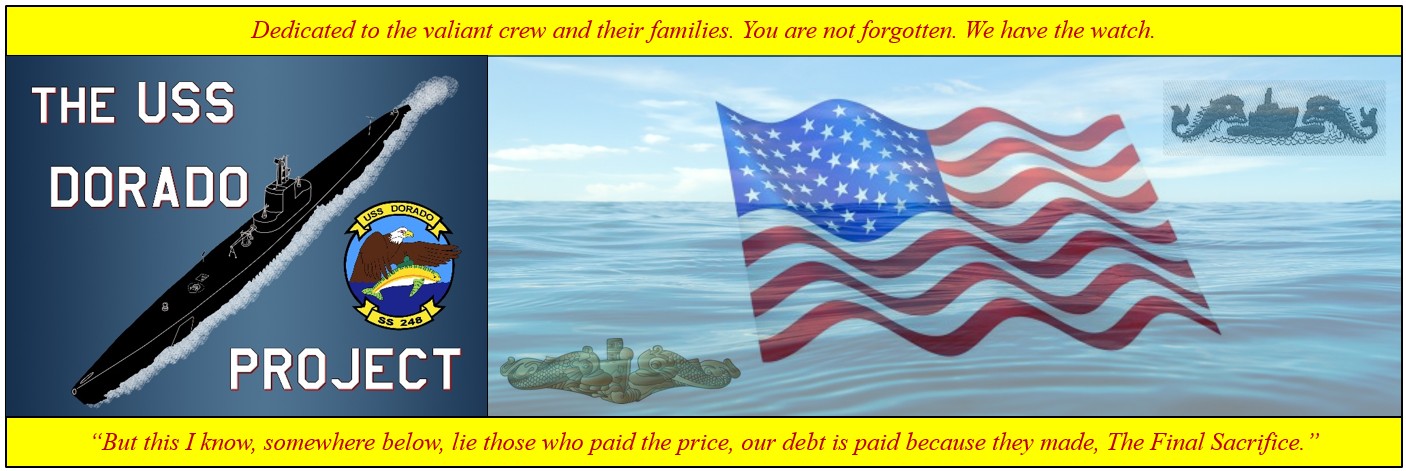Dorado Crew: Difference between revisions
Pbcjohnston (talk | contribs) Finished Schneider section |
Pbcjohnston (talk | contribs) Added Chiefs section |
||
| Line 19: | Line 19: | ||
[[File:Earle Caffrey Schneider.jpg|right|thumb|125px|LCDR E.C. Schneider, USN]] | [[File:Earle Caffrey Schneider.jpg|right|thumb|125px|LCDR E.C. Schneider, USN]] | ||
<div style="text-align: justify;"><span style="color:#00008B">For the Dorado that man was LCDR Earle Caffrey Schneider. A native of Beaufort, North Carolina, Schneider had the Navy in his blood. His father was a wisened, experienced, and "salty" Chief Petty Officer | <div style="text-align: justify;"><span style="color:#00008B">For the Dorado that man was LCDR Earle Caffrey Schneider. A native of Beaufort, North Carolina, Schneider had the Navy in his blood. His father was a wisened, experienced, and "salty" Chief Petty Officer with over 36 years of service. Because of his father's service Schneider had spent his formative years around ships and navy bases. He was a good student, and this got him an appointment to the Naval Academy in 1929, as a part of the class of 1933. After graduation and commissioning he served aboard the battleship [https://www.navsource.net/archives/01/38a.htm '''Pennsylvania (BB-38)'''] and the carrier [https://www.navsource.net/archives/02/04.htm '''Ranger (CV-4)'''] before transferring to submarines. Schneider, known to his friends by the jocular nom de guerre "Penrod", served on the [[181|'''Pompano (SS-181)''']] from 1939 to 1942 and made his first war patrols aboard her. He then transferred to [https://www.navsource.net/archives/08/08237.htm '''Trigger (SS-237)'''] and made several very successful war patrols as her Executive Officer (XO), or second in command. With the Submarine Service rapidly expanding with the war effort, experienced men were needed to man the new boats being built at Electric Boat, Portsmouth, and the other yards. After two war patrols on Trigger, Schneider was detached to return to New London to put the Dorado into commission as her Commanding Officer.<br><br> | ||
<div style="text-align: justify;"><span style="color:#000000"> | |||
[[File:CRM ODell Dorado.jpg|left|thumb|125px|CRM Paul F. O'Dell, USN]] | |||
<div style="text-align: justify;"><span style="color:#00008B">In the United States Navy, there is an old saying that pontificates "The officers are in charge, but the Chiefs run the Navy." A Chief Petty Officer was the highest rank for an enlisted man during the war years. Chiefs wear their gold fouled anchor and USN badge on their combination cap with pride, as they are respected as highly experienced and expert sailors, often with decades of service from the lowest Seaman all the way up. A Chief has done everything, seen everything, and been everywhere. They are considered to be technical experts and leaders of men. They are the "get-it-done" element on any Navy ship, organizing and leading work parties of junior sailors, mentoring them, teaching them, and at times keeping them in-line with iron discipline. Many new enlisted men look to the Chiefs like father figures, the guidance and advice they provide filling a gap that the young men experience from the families they recently left behind. Their experience, wisdom, and technical know-how is sought out even by the junior officers (Ensigns, Lieutenant Junior Grades, etc.) as they learn the tricks of the trade. Dorado had eight Chief's assigned to help train the crew, a large percentage of which were brand new sailors and not yet [[Qualification Books|'''Qualified in Submarines''']]. They were the nucleus of the crew, and the officer's relied on them to a great extent indeed. | |||
Revision as of 18:11, 26 June 2025

| Main Page | Latest News & Updates | The Submarine | The Crew | Photographs | The Loss Scenario | The Aircraft | Case for the Purple Heart | The Myths | Research Documents |

The crew is lead by its officers, college educated men that provide the boat with its direction and resolve. At the top is the Commanding Officer (aka CO or Skipper), a seasoned veteran and experienced man of the sea, a man who knows the "art" of submarining down to its core. During WWII the CO could be a senior Lieutenant (LT), but was most often a Lieutenant Commander (LCDR) or Commander (CDR). By 1943 the CO of a fleet submarine had risen up through the officer ranks, having served on several submarines previously, and had likely also had surface ship experience. He would be intelligent and driven, capable of multi-tasking on a high level. He would be capable of solving complex mathematical calculations quickly in his head, all the while managing a complex fighting machine in a calm and decisive manner.


Page created by:
Thaddeus Weaver & David Johnston
©2025 - Thaddeus Weaver & PigBoats.COM
West Warwick, RI, Norfolk, VA
ussdoradoproject@gmail.com